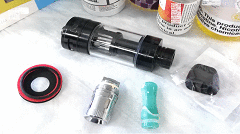当前位置:
X-MOL 学术
›
Chem. Res. Toxicol.
›
论文详情
Our official English website, www.x-mol.net, welcomes your feedback! (Note: you will need to create a separate account there.)
Emerging Chemicals of Health Concern in Electronic Nicotine Delivery Systems.
Chemical Research in Toxicology ( IF 4.1 ) Pub Date : 2020-09-03 , DOI: 10.1021/acs.chemrestox.0c00281 Binnian Wei 1 , Richard J O'Connor 1 , Maciej Lukasz Goniewicz 1 , Andrew Hyland 1
Chemical Research in Toxicology ( IF 4.1 ) Pub Date : 2020-09-03 , DOI: 10.1021/acs.chemrestox.0c00281 Binnian Wei 1 , Richard J O'Connor 1 , Maciej Lukasz Goniewicz 1 , Andrew Hyland 1
Affiliation

|
Electronic nicotine delivery systems (ENDS), by virtue of their highly engineered construction (plastics, glass, e-liquids), may contain a number of emerging chemicals of concern (ECCs), including phthalates, phenolic compounds, and flame retardants. Current knowledge regarding the safety of ENDS may underestimate the health risks from ECCs. In this study, we examined the types and levels of those three groups of chemicals in the components and parts of ENDS devices, including refill liquids, tanks/cartridges, atomizers, drip tips/mouthpieces, and sealing materials. Our results suggest that phthalates were the most prevalent chemicals in all tested samples, followed by parabens and organophosphate flame retardants (OPFRs). Particularly, all measured chemicals had significantly higher detection rates in cartridges/tanks, drip tips/mouthpieces, and sealing materials in contrast to e-liquids and coil samples. Among all those three types of ENDS components, phthalates generally had the highest concentrations (0.279–3790 ng/unit) in the drip tip/mouthpiece samples, followed by the sealing materials (0.380–508.8 ng/unit) and the empty tank/cartridge samples (up to 761.7 ng/unit). For parabens, highest concentrations were observed in drip tip/mouthpiece samples (1.152–130.1 ng/unit), followed by sealing materials (0.220–30.08 ng/unit) and the tank/cartridge samples (1.794–34.24 ng/unit). For OPFRs, tris(1,3-dichloro-2-propyl) phosphate had the highest concentrations (39.40–774.1 ng/unit) in all component samples. High concentrations (20.25–260.4 ng/unit) were also observed for several OPFRs in sealing materials and drip tip/mouthpiece samples. These findings will contribute to addressing the information gaps pertinent to the presence of ECCs in ENDS and will warrant further studies for understanding the potential negative health effects and to what extent those chemicals may cause potential negative health effects when using the ENDS. The findings will also contribute to developing evidence-based standards for the regulatory control of the types and levels of ECCs in ENDS products.
中文翻译:

电子尼古丁传输系统中涉及健康的新兴化学品。
电子尼古丁输送系统 (ENDS) 由于其高度工程化的结构(塑料、玻璃、电子液体),可能含有许多新兴的令人关注的化学物质 (ECC),包括邻苯二甲酸盐、酚类化合物和阻燃剂。目前有关 ENDS 安全性的知识可能低估了 ECC 的健康风险。在这项研究中,我们检查了 ENDS 设备组件和部件中这三组化学品的类型和含量,包括补充液、储罐/药筒、雾化器、滴嘴/吸嘴和密封材料。我们的结果表明,邻苯二甲酸盐是所有测试样品中最常见的化学物质,其次是对羟基苯甲酸酯和有机磷酸酯阻燃剂 (OPFR)。特别是,与电子液体和线圈样品相比,所有测量的化学物质在烟弹/罐、滴嘴/吸嘴和密封材料中的检出率明显更高。在所有这三种类型的 ENDS 成分中,滴嘴/吸嘴样品中邻苯二甲酸盐的浓度通常最高(0.279–3790 ng/单位),其次是密封材料(0.380–508.8 ng/单位)和空罐/药筒样品(高达 761.7 纳克/单位)。对于对羟基苯甲酸酯,在滴嘴/吸嘴样品中观察到最高浓度(1.152–130.1 ng/单位),其次是密封材料(0.220–30.08 ng/单位)和罐/墨盒样品(1.794–34.24 ng/单位)。对于 OPFR,磷酸三(1,3-二氯-2-丙基)酯在所有成分样品中浓度最高(39.40–774.1 ng/单位)。在密封材料和滴嘴/吸嘴样品中也观察到多种 OPFR 的高浓度(20.25–260.4 ng/单位)。这些发现将有助于解决与 ENDS 中 ECC 存在相关的信息差距,并需要进一步研究以了解潜在的负面健康影响以及这些化学物质在使用 ENDS 时可能在多大程度上造成潜在的负面健康影响。研究结果还将有助于制定基于证据的标准,以监管 ENDS 产品中 ECC 的类型和水平。
更新日期:2020-10-21
中文翻译:

电子尼古丁传输系统中涉及健康的新兴化学品。
电子尼古丁输送系统 (ENDS) 由于其高度工程化的结构(塑料、玻璃、电子液体),可能含有许多新兴的令人关注的化学物质 (ECC),包括邻苯二甲酸盐、酚类化合物和阻燃剂。目前有关 ENDS 安全性的知识可能低估了 ECC 的健康风险。在这项研究中,我们检查了 ENDS 设备组件和部件中这三组化学品的类型和含量,包括补充液、储罐/药筒、雾化器、滴嘴/吸嘴和密封材料。我们的结果表明,邻苯二甲酸盐是所有测试样品中最常见的化学物质,其次是对羟基苯甲酸酯和有机磷酸酯阻燃剂 (OPFR)。特别是,与电子液体和线圈样品相比,所有测量的化学物质在烟弹/罐、滴嘴/吸嘴和密封材料中的检出率明显更高。在所有这三种类型的 ENDS 成分中,滴嘴/吸嘴样品中邻苯二甲酸盐的浓度通常最高(0.279–3790 ng/单位),其次是密封材料(0.380–508.8 ng/单位)和空罐/药筒样品(高达 761.7 纳克/单位)。对于对羟基苯甲酸酯,在滴嘴/吸嘴样品中观察到最高浓度(1.152–130.1 ng/单位),其次是密封材料(0.220–30.08 ng/单位)和罐/墨盒样品(1.794–34.24 ng/单位)。对于 OPFR,磷酸三(1,3-二氯-2-丙基)酯在所有成分样品中浓度最高(39.40–774.1 ng/单位)。在密封材料和滴嘴/吸嘴样品中也观察到多种 OPFR 的高浓度(20.25–260.4 ng/单位)。这些发现将有助于解决与 ENDS 中 ECC 存在相关的信息差距,并需要进一步研究以了解潜在的负面健康影响以及这些化学物质在使用 ENDS 时可能在多大程度上造成潜在的负面健康影响。研究结果还将有助于制定基于证据的标准,以监管 ENDS 产品中 ECC 的类型和水平。



























 京公网安备 11010802027423号
京公网安备 11010802027423号